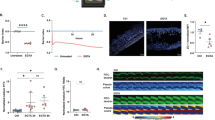Abstract
Gut barrier function has been hypothesized to play a critical role in the pathophysiology of sepsis. Measuring intestinal permeability allows for a determination of barrier dysfunction under conditions of health and disease. Fluorescence-conjugated dyes such as fluorescein isothiocyanate-4 kDa dextran (FD4) have been commonly used for evaluating hyperpermeability. Here we describe a common method to measure gut permeability in vivo, following gavage with different sized dyes. In addition, we describe an ex vivo everted gut sac model that allows for discrimination of permeability by segmental geographic location along the intestine.
Access this chapter
Tax calculation will be finalised at checkout
Purchases are for personal use only
Similar content being viewed by others
References
Meng M, Klingensmith NJ, Coopersmith CM (2017) New insights into the gut as the driver of critical illness and organ failure. Curr Opin Crit Care 23:143–148
Mittal R, Coopersmith CM (2014) Redefining the gut as the motor of critical illness. Trends Mol Med 20:214–223
Lorentz CA, Liang Z, Meng M et al (2017) Myosin light chain kinase knockout improves gut barrier function and confers a survival advantage in polymicrobial sepsis. Mol Med 23:155–165
Clark JA, Clark AT, Hotchkiss RS et al (2008) Epidermal growth factor treatment decreases mortality and is associated with improved gut integrity in sepsis. Shock 30:36–42
Turner JR (2009) Intestinal mucosal barrier function in health and disease. Nat Rev Immunol 9:799–809
Garcia-Hernandez V, Quiros M, Nusrat A (2017) Intestinal epithelial claudins: expression and regulation in homeostasis and inflammation. Ann N Y Acad Sci 1397:66–79
Tsukita S, Tanaka H, Tamura A (2019) The Claudins: from tight junctions to biological systems. Trends Biochem Sci 44:141–152
Odenwald MA, Turner JR (2017) The intestinal epithelial barrier: a therapeutic target? Nat Rev Gastroenterol Hepatol 14:9–21
Tsai PY, Zhang B, He WQ et al (2017) IL-22 upregulates epithelial Claudin-2 to drive diarrhea and enteric pathogen clearance. Cell Host Microbe 21:671–681. e4
Alam MA, Al-Jenoobi FI, Al-Mohizea AM (2012) Everted gut sac model as a tool in pharmaceutical research: limitations and applications. J Pharm Pharmacol 64:326–336
Yoseph BP, Klingensmith NJ, Liang Z et al (2016) Mechanisms of intestinal barrier dysfunction in sepsis. Shock 46:52–59
Acknowledgments
The authors declare no conflict of interests related to the current study. This work was supported by the National Institutes of Health under grants (GM072808, AA027396, GM104323, GM113228).
Author information
Authors and Affiliations
Corresponding author
Editor information
Editors and Affiliations
Rights and permissions
Copyright information
© 2021 Springer Science+Business Media, LLC, part of Springer Nature
About this protocol
Cite this protocol
Oami, T., Coopersmith, C.M. (2021). Measurement of Intestinal Permeability During Sepsis. In: Walker, W.E. (eds) Sepsis. Methods in Molecular Biology, vol 2321. Humana, New York, NY. https://doi.org/10.1007/978-1-0716-1488-4_15
Download citation
DOI: https://doi.org/10.1007/978-1-0716-1488-4_15
Published:
Publisher Name: Humana, New York, NY
Print ISBN: 978-1-0716-1487-7
Online ISBN: 978-1-0716-1488-4
eBook Packages: Springer Protocols




